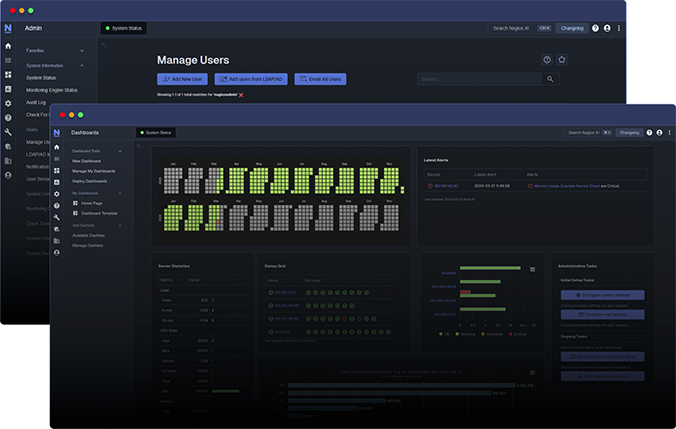More Power, Less Effort.
Enjoying the power of Nagios Core? Upgrade to the Nagios Core Services Platform, which bundles Core and XI together.
Nagios XI is built on Core, but automates the work you’re doing manually—like configurations, alerts, and reporting. Get more done in less time, without needing to dig into command lines every day.

You’ve mastered Nagios Core and scripting is second nature. But what if you could spend less time setting things up and more time focusing on what matters?
Nagios XI, our premier monitoring solution featured on Nagios CSP, goes far beyond Core. XI offers a fully integrated platform with easy-to-use Configuration Wizards, pre-installed integrations, and an intuitive dashboard, all designed to take the hassle out of monitoring so you can get more done, faster.
No need to dive into manual configurations—Monitoring Wizards handle the setup for you, but you still have the flexibility to tweak things your way.
Get a complete view of your environment with customizable dashboards and built-in performance graphs—no extra steps required.
Access powerful reports and visualizations that give you deeper insights, without manual effort.
Migrating from Nagios Core to XI involves a few key steps to get you up and running. We’ve outlined the main steps here to help guide you through the process. For a deeper dive into the migration, check out our Roadmap for Making the Upgrade From Core to XI , and if you need more detailed instructions, be sure to visit our full guide to Migrating From Core to XI.
For advanced setups, like distributed monitoring environments, additional configuration may be needed. Please refer to our documentation for more details.
You can now automatically migrate Nagios Core data to Nagios XI. See Automatic Nagios Core Migration to Nagios XI for more information.
In order to migrate from Nagios Core to Nagios XI, you should deploy a clean installation of Nagios XI to a different physical server or virtual machine than what is used for your existing Nagios Core installation. This allows you to migrate settings to XI and test the new monitoring setup before decommissioning your old server.
To use your custom plugins and scripts in Nagios XI, you’ll need to upload them to the /usr/local/nagios/libexec directory. You can do this easily through the XI web interface under the Admin menu. For more details, check out the Managing Plugins in Nagios XI guide. Custom event handlers or notification scripts should also be placed in the same directory or in a subfolder like /eventhandlers.
When migrating to Nagios XI, you can bring over your Nagios Core configuration files, including hosts, services, commands, and more. You have two options: manually maintain the configuration files or import them into the Core Config Manager (CCM) database. You can also mix and match—starting with manual files and importing later, or importing some files while keeping others manually maintained.
Navigate to the Core Config Manager (CCM), then go to Tools > Import Config Files. Import in the correct order, ensuring all required objects exist.
After importing, validate your configuration files before applying changes.
Once verified, use the Apply Configuration option to restart Nagios Core with the new setup.
After migrating your Nagios Core configurations to Nagios XI, you’ll need to add user accounts for access to the XI web interface. You can create new users through Admin > Users > Manage Users. Nagios XI allows users to manage their notification preferences, but if you have custom or advanced schedules from Nagios Core, you can retain those settings. For more details, check out the Understanding Nagios XI Users and Contacts documentation.
Let users manage notifications in XI by matching the username to the Nagios Core contact and selecting “Create as Monitoring Contact.”
Retain advanced notification settings by matching the username but unchecking the “Create as Monitoring Contact” option to prevent XI from overwriting Core settings.
Make sure you test your new XI server to ensure it is operating effectively. Items you should check include:
• Host and service checks are operating properly and returning the expected results
• Notifications are functioning properly
Once you have migrated the plugins, scripts, and configuration files from your old Nagios Core installation and have successfully verified Nagios XI’s operation, you may decommission the old Nagios Core server. Before doing so, it is recommended that you retain a backup of the server and its Nagios Core configuration in case you need them in the future.
Need help getting started? Here’s a collection of resources to guide you through the switch: